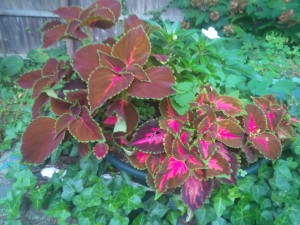
If you happen to be a flashy individual who changes your name every few years and carries on colorfully in public places, you might be called a “performance artist”, or possibly something even more descriptive. If you were to morph into plant form and do the same thing, gardeners would simply ignore all the name changes and call you “coleus”.
With leaves in a multitude of colors and eye-catching patterns, coleus is dear to the hearts of everyone who yearns for excitement in shaded spaces. Long ago, its ancestors thrived in tropical Africa, parts of Southeast Asia and southern Australia. Now, coleus is known worldwide as a staple foliage plant, showing up in borders, containers, window boxes and public plantings all over North American and beyond. Coleus also seems to transcend all kinds of barriers, available in the biggest of big-box stores and the snootiest specialty nurseries. This is quite an accomplishment for a plant that is both cheap and easy.
Victorians were straight-laced about many things, but not about color in the garden. They lapped it up, which is where coleus came in. According to Alison Kyle Leopold’s 1995 book, The Victorian Garden, the plants were introduced to Europe and America in the second half of the nineteenth century. Splashing around with leaves in every color but blue, coleus became indispensible in both parlors and gardens. Parlor accommodations were particularly necessary in cold winter climates, because coleus cannot survive outside of USDA plant hardiness zones 10-11.
Originally the plants were christened Coleus blumei, after Karl Ludwig von Blume, a nineteenth century German-Dutch botanist, who discovered coleus while botanizing in the Dutch colony of Java. “Coleus” is derived from the Greek “koleos”, which means “sheath” and refers to the flowers’ stamens, which are fused into a sheath-like structure. No one notices this, of course, because most people ignore or remove the flowers. Eventually, plant taxonomists renamed the showy species Coleus scutellarioides. The species name comes from the Latin “scutella”, meaning dish-shaped and also referring to those less-than-glamorous flowers.
We dirt gardeners have gotten used to the name “coleus”, which is probably why plant taxonomists were so eager to change it. In the late twentieth century, it was renamed “Solenostemon scutellarioides”. Now genetic research has placed the coleus in a different genus, Plectranthus. If you are going to be botanically correct, you will now refer to your nearest coleus as Plectranthus scutellarioides.
Of course, you might also call it “painted nettle”, which is an old-fashioned, non Latin-derived nickname.
Plant vendors don’t’ want to confuse buyers and still call the plants “coleus”. When you plant your next coleus, consider the stem, which is square in cross section, marking the species as a member of the large mint–Labiatae or Lamiaceae—family. Like all mints, it will grow on a dirty kitchen floor if allowed the opportunity. Generally, I buy a few specimens of the best-looking varieties each year and take cuttings all season long to fill my containers and garden dead spots. Coleus will root readily in a glass of water. I have found that if I take a four-inch cutting, remove the lower leaves and plant the cutting directly into a soil-filled container, it will also root readily.
At the end of the growing season, if you really love a particular coleus variety, take cuttings, root or plant them and remove the container to a sunny windowsill indoors. Keep the specimen watered and away from drafts and it will grow nicely, allowing you to start taking cuttings the following spring.
Many coleus bear leaves that are triangular in shape, but some may have deeply dissected or lobed foliage as well. The variety of shapes, forms and colors is almost endless. The White Flower Farm catalog alone features 28 different coleus varieties, including the popular ‘Inky Fingers’, with dark maroon lobed leaves edged in acid green. The Color Blaze® series is notable for its glowing hues.
Most catalog vendors have sold out of coleus by this time of the summer, but local garden centers still have plants. A number of those plants are now in large pots, having started out in cell packs in the late spring and ballooned into statuesque creatures. This is an excellent situation, because you can cut back the lanky stems and root them. This heavy pruning will also encourage branching in the parent plant.
And if you can’t remember the latest Latin name, don’t worry. Ninety-nine percent of gardeners still call it “coleus”.
